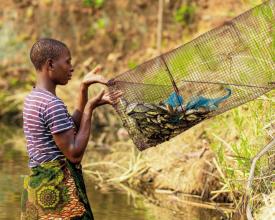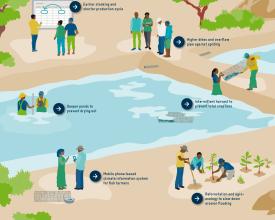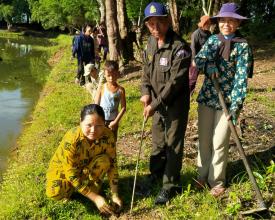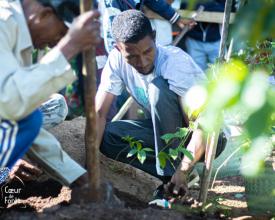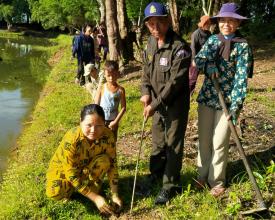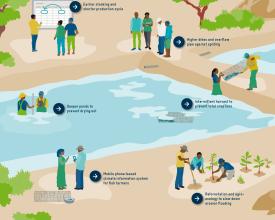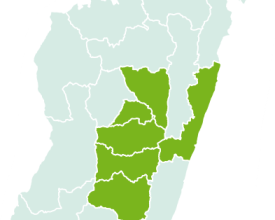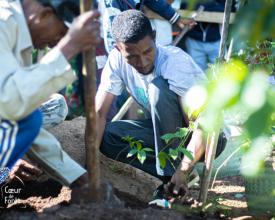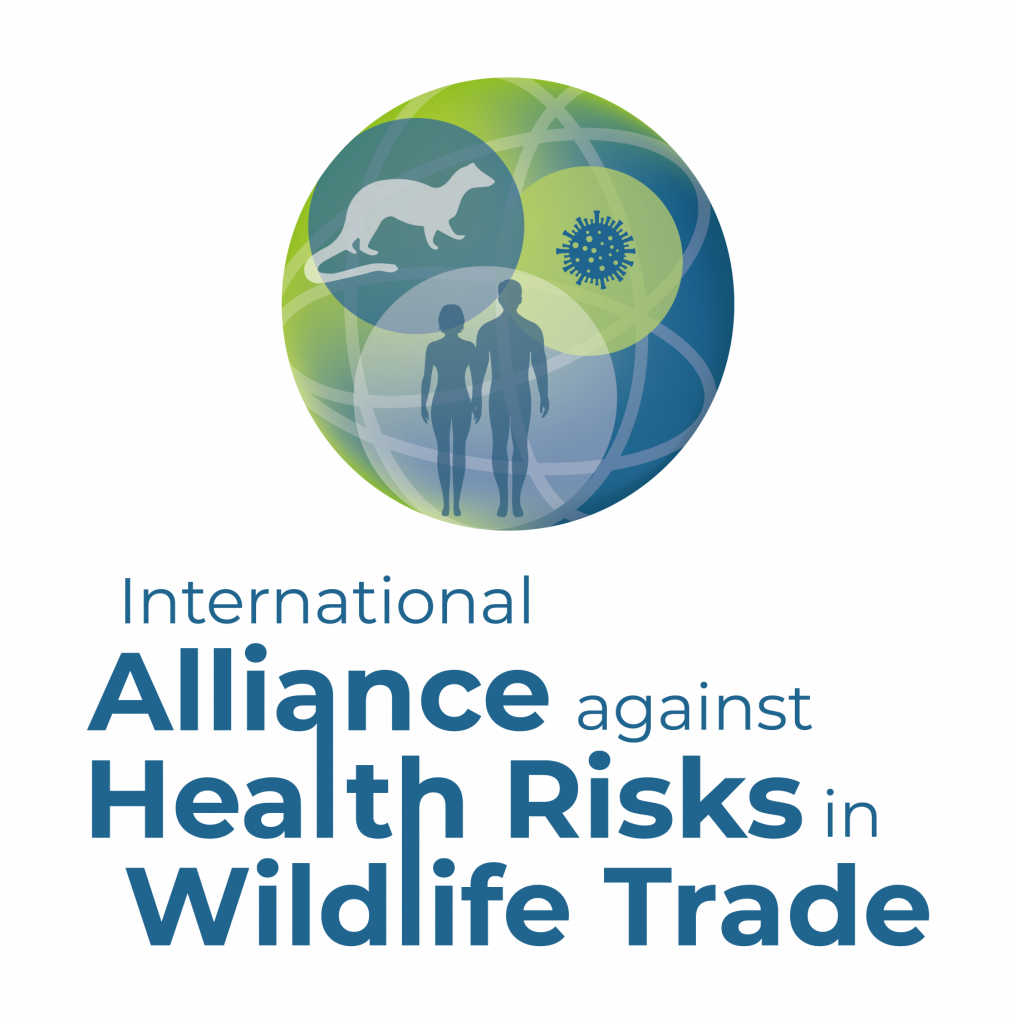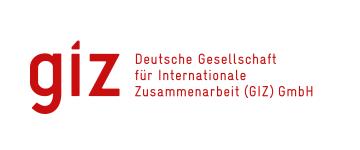
Adapting to climate change: Innovative techniques in the smallholder aquaculture sector

In response to challenges faced by small-scale aquaculture farmers due to climate change, the Global Programme Sustainable Fisheries and Aquaculture (GP Fish), implemented by the Deutsche Gesellschaft für Internationale Zusammenarbeit (GIZ), developed adaptation strategies for the sub-sector to mitigate these impacts. These strategies include the intermittent harvest method, the implementation of agroforestry practices, and digital climate information systems.
Contexte
Défis à relever
Small-scale enterprises in the aquaculture sector of southeast Africa face considerable challenges due to climate change, which severely affects water availability, disease prevalence, and farm productivity. Already now, extreme weather events like floods or dry spells can lead to severe crop losses across entire regions if not addressed adequately by fish farmers. Climate-driven changes in temperature and precipitation are expected to have long-term impacts on the aquaculture sector at multiple levels.
Emplacement
Traiter
Résumé du processus
This holistic approach of studying the threats of climate change on the aquaculture sector, coupled with piloting and implementing mitigation strategies, combines structural improvements, innovations, and strategic regional support systems. Over a thousand fish farmers have been trained on understanding climate change, implementing adaptation measures and the application of agroecological principles. The training ensures that the farmers are well-prepared to face future climatic challenges and to continue productive operations.
Blocs de construction
Approach
Adapted to the country specific contexts, different measures are being used for the GP Fish’s intervention areas. However, the procedure is similar, starting with studying the individual effects of climate change to the region, piloting mitigation strategies to curb them and then implementing the most effective solutions.
In 2022, the GP Fish conducted a vulnerability study for the freshwater aquaculture sector in Madagascar on behalf of the German Federal Ministry for Economic Cooperation and Development (Bundesministerium für wirtschaftliche Zusammenarbeit und Entwicklung, BMZ). Public, private, and society actors of the sector reflected jointly on the impacts of climate change and developed adaptation measures for pond farming and rice-fish culture.
Moreover, in cooperation with the Lilongwe University of Agriculture and Natural Resources and the former Sectoral Programme for Sustainable Fisheries and Aquaculture, the project researched and implemented measures to protect fish farmers from the total loss of fish stock due to extreme weather events through intermittent harvest.
The aquaculture adaptations were applied and supported through training and consulting services, accompanied by additional activities like the implementation of a mobile phone-based climate information system.
Conducting vulnerability study
The vulnerability study follows the methodology of the GIZ Vulnerability Sourcebook which uses the vulnerability definition by the AR4 of the IPCC. As a starting point, temperature and precipitation in six focus regions in Madagascar were analysed and climate project maps were created. They served as a basis for the impact analysis. In three interregional workshops, impact chains and adaptation measures were developed by private, public, and civil society actors of the aquaculture sector. In a national workshop these findings were shared and verified. Fish farmers in the Highlands and on the east coast participated in capacity building activities on climate change adaptation.
Overall, the results revealed a high vulnerability of the freshwater aquaculture sector in all six focus regions in Madagascar. The models predict a significant reduction of rainfall, an increase of the number of days without rain and more frequent extreme weather events until 2060. More cyclones (and more intense cyclones) imply flood and erosion and a siltation of rice fields. More frequent and longer droughts lead to a lack of water, shorter production cycles and delays in the fish farming season. Furthermore, extreme weather events can create “panic sales” at low prices which affects the economic performance of fish farmers.
Piloting intermittent harvest technique
Through joint efforts the project, Lilongwe University, a method for intermittent harvesting was developed, based on expert discussions and literature research. The size-selective fish trap was designed for easy and regular harvest of juvenile fish in mixed-sex tilapia cultures, mitigating the risk of a total loss of fish crop due to extreme weather events. Next to the better management of the pond’s carrying capacity, the low-cost fish trap was expected to improve household nutrition and cash flow of small-scale aquaculture farmers. In a series of experiments different fish species, stock densities and time intervals for the use of the trap were tested. On-farm trials were conducted to test the innovation’s use in the field. With the application of the trap for intermittent harvest the total yields under optimal conditions were 25 percent higher than in the control group with single batch harvest. Throughout the three-month trial in the field, the farmers used the trap two to three times a week. An average of 830 g of small but marketable fish was caught each time, adding up to over 20 kg of continuous fish supply for the farmer.
This additional catch provided a steady source of food for the household or could be sold at favourable prices, especially when local market fish supplies were low during the aquaculture cycle.
Rolling out mitigation strategies
Complex problems require systemic solutions that operate in different dimensions and at different levels.
Based on the vulnerability study results and the piloting intermittent harvest technique, the GP Fish supported various initiatives to enhance the resilience of aquaculture and rice-fish farmers. Through training sessions, farmers learned about the impacts of climate change on aquaculture operations. With support from technical staff, fish farmer cooperatives developed individual adaptation plans, which were then incorporated into their annual planning. Additionally, farmers received training on enhancing watershed functionality and implementing agroforestry practices, including reforestation around ponds to reduce erosion during heavy rains. Due to high community demand, the project also supported the development and management of local tree nurseries to ensure the availability of seedlings.
Other infrastructural adaptations for small-scale aquaculture operations include the use of deeper ponds, which provide thermal refuge and greater dissolved oxygen reserves, thus enhancing fish growth and survival during dry spells. Structural adaptations such as raised pond dikes and strategic timing for stocking and harvesting fish are recommended to prevent losses during seasonal extreme weather events.
Moreover, continuous harvesting of surplus tilapia offspring reduced the risk of total market value loss due to flooding, showcasing an innovative adaptation to increase resilience against climate variability. The cost-efficient adaptations and techniques were carefully selected to minimize the financial burden on farmers.
These adaptations on an infrastructural level can be complemented by regional activities of the project to mitigate climate change effects. For example, a digital, mobile phone-based climate information system for fish farmers has been introduced in collaboration with mobile network operators and weather stations. The hotline provides early and regular weather updates, which allows farmers to adjust production and harvesting methods to prevent losses from events such as flooding. Additionally, the hotline serves as a marketplace for fish producers and consumers.
Impacts
This holistic approach of studying the threats of climate change on the aquaculture sector, coupled with piloting and implementing mitigation strategies, combines structural improvements, innovations, and strategic regional support systems. The benefits include reduced loss of fish and income, and increased resilience against climate effects.
Over a thousand fish farmers have been trained on understanding climate change, implementing adaptation measures and the application of agroecological principles. The training ensures that the farmers are well-prepared to face future climatic challenges and to continue productive operations. Additionally, reforestation measures in the watersheds, ponds, and rice fields help reduce erosion and improve water retention and absorption in the soil. This contributes to mitigating the adverse effects of prolonged droughts or heavy rainfalls and flooding.
Likewise, the intermittent harvest technique has proven to not only ease the adverse effects of losses during flooding events but has also shown that households have significantly increased their fish consumption (e.g., from once a month to twice a week) and cash flow outside of the harvesting season. Finally, the digital climate information system provides targeted weather updates and alerts on health risks, which are crucial for managing agricultural activities effectively amid the growing challenges of climate change.
Bénéficiaires
Sustainable livelihoods for small-scale aquaculture farmers through adaptation strategies and technical training.
Mitigating climate change risks and impacts for rural communities.
Avoiding harvest losses while contributing to food and nutrition security.
Objectifs de développement durable
Histoire
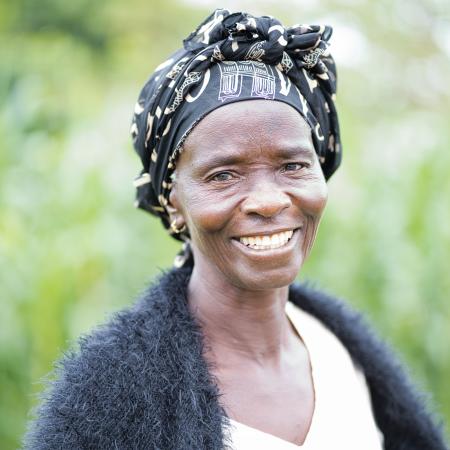
More fish than ever before: in Zambia sustainable pond aquaculture is improving many people’s lives. It has helped 9,000 businesses to markedly increase their fish production, while 26,000 people have acquired fishing licences and almost 1,000 Zambians have doubled their income. In addition, the people there now also have a healthier diet.
Today, Theresa Oposhi (54), a single mother and grandmother from the village of Chitamba in northern Zambia, has eight ponds in which she produces around 20 kg of fish per month.
"Fish farming enables me to meet my basic needs and those of my grandchildren," she says. The family members cook some of the fish for themselves. The rest is sold. Oposhi uses the income to buy fertiliser for her field of maize, fish food and food for the family – a self-supporting system.
She learned everything she needed for this in a training course lasting a few weeks - such as how to farm and market healthy fish. This enabled her to expand her four ponds to eight and to make them particularly climate-resilient, so they will also stand up to extreme weather events such as droughts and rainstorms. They are now larger and deeper, their walls are more stable, and the water is distributed through pipes. Oposhi would like to produce even more in the future. She also acts as a shining example to other members in her community and encourages other villagers to start fish farming.
"I have seen many benefits in fish farming; I can provide basic needs for myself and my grandchildren through the income I get from the few kgs of fish I sale."
Theresa Oposhi

